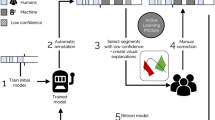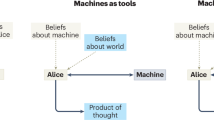Abstract
Machine learning techniques are often used for supporting a knowledge engineer in constructing a model of part of the world. Different learning algorithms contribute to different tasks within the modeling process. Integrating several learning algorithms into one system allows it to support several modeling tasks within the same framework. In this article, we focus on the distribution of work between several learning algorithms on the one hand and the user on the other hand. The approach followed by the MOBAL system is that ofbalanced cooperation, i.e., each modeling task can be done by the user or by a learning tool of the system. The MOBAL system is described in detail. We discuss the principle of multi-functionality of one representation for the balanced use by learning algorithms and users.
Article PDF
Similar content being viewed by others
Explore related subjects
Discover the latest articles, news and stories from top researchers in related subjects.Avoid common mistakes on your manuscript.
References
Davies, T.R., & Russell, S.J. (1987). A logical approach to reasoning by analogy.Proceedings of IJCAI-87. Morgan Kaufmann.
Emde, W., Habel, C., & Rollinger, C.-R. (1983). The discovery of the equator or concept-driven learning.Proceedings of IJCAI-83. Morgan Kaufmann.
Kietz, J.-U., & Morik, K. (1991). Constructive induction: Learning concepts for learning.Arbeitspapiere der GMD, No. 543.
Kietz, J.-U., & Wrobel, S. (1991). Controlling the complexity of learning through syntactic and task-oriented models. In S. Muggleton (Ed.),Inductive logic programming, London: Academic Press.
Kietz, J.-U. (1988). Incremental and reversible acquisition of taxonomies. In M. Linster, J. Boose, & B. Gaines (Eds.),Proceedings of EKAW-88. GMD-Studien 143.
Klingspor, V. (1991). MOBAL's predicate structuring tool.Deliverable 4.3.2/G of the MLT project (MLT-Report, No. GMD/P2154/22/1).
Kodratoff, Y., & Tecuci, G. (1989). The central role of explanations in DISCIPLE. In K. Morik (Ed.),Knowledge Representation and Organization in Machine Learning. New York: Springer.
Michalski, R.S. (1991). Inferential learning theory as a basis for multistrategy task-adaptive learning. In R.S. Michalski & G. Tecuci (Eds.),First International Workshop on Multistrategy Learning. West Virginia.
Morik, K. (1989). Sloppy modeling. In K. Morik (Ed.),Knowledge Representation and Organization in Machine Learning. New York: Springer.
Morik, K., & Kietz, J.-U. (1989). A bootstrapping approach to conceptual clustering. In A. Serge (Ed.),Proceedings of 6th IWML. San Mateo: Morgan Kaufmann.
Morik, K. (1991). Underlying assumptions of knowledge acquisition and machine learning.Knowledge Acquisition Journal, 3, 137–156.
Morik, K., Causse, K., & Boswell, R. (1991). A common knowledge representation integrating learning tools. In R.S. Michalski & G. Tecuci (Eds.),First International Workshop on Multistrategy Learning, West Virginia.
Quinlan, R. (1983). Learning efficient classification procedures and their application to chess end games. In R.S. Michalski, J.G. Carbonell, & T. Mitchell.Machine learning—An artificial intelligence approach, vol. I, Palo Alto, CA: Tioga.
Quinlan, R. (1990). Learning logical definitions from relations.Machine Learning Journal, 3, 239–266.
Shapiro, E.Y. (1981). Inductive inference from facts. (Yale Research Report No. 192). Yale University, New Haven, CT.
Thieme, S. (1989). The acquisition of model knowledge for a model-driven machine learning approach. In K. Morik (Ed.),Knowledge representation and organization in machine learning. New York: Springer.
Wrobel, S. (1987). Higher-order concepts in a tractable knowledge representation. In K. Morik (Ed.),Proceedings of the German Workshop on AI. Berlin, Heidelberg: Springer.
Wrobel, S. (1989). Demand-driven concept formation. In K. Morik (Ed.),Knowledge representation and organization in machine learning. New York: Springer.
Wrobel, S. (1993). On the proper definition of minimality in specialization and theory revision. In P. Brazdil (Ed.),Machine learning-ECML-93, New York: Springer.
Author information
Authors and Affiliations
Rights and permissions
About this article
Cite this article
Morik, K. Balanced cooperative modeling. Mach Learn 11, 217–235 (1993). https://doi.org/10.1007/BF00993078
Received:
Accepted:
Issue Date:
DOI: https://doi.org/10.1007/BF00993078




